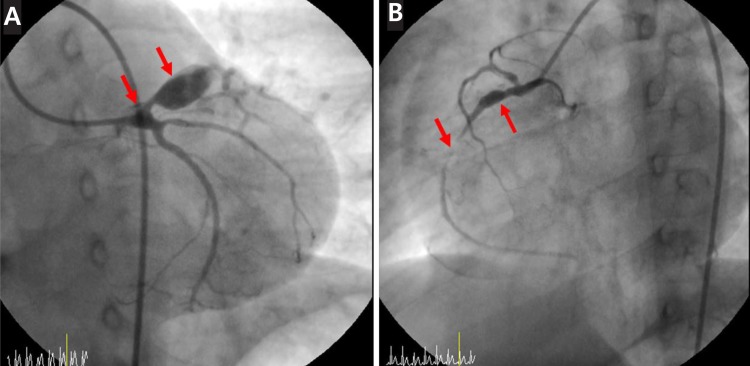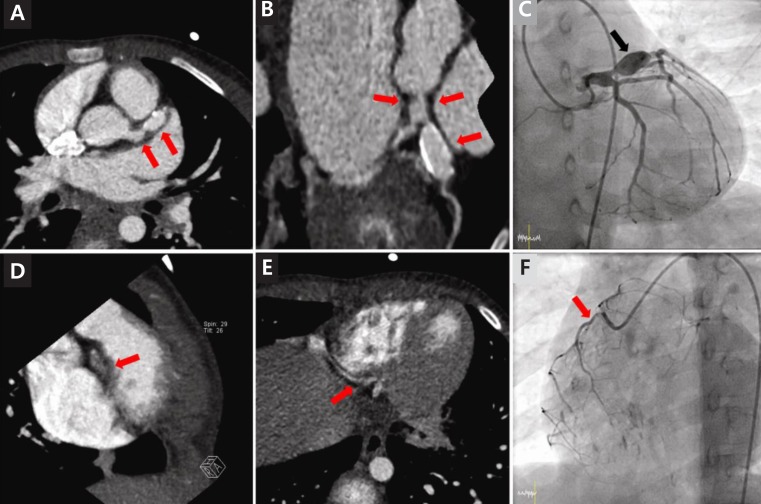All issues > Volume 58(12); 2015
Giant coronary aneurysm caused by Kawasaki disease: consistency between catheter angiography and electrocardiogram gated dual-source computed tomography angiography
- Corresponding author: Min-Jung Cho, MD. Department of Pediatrics, Pusan National University Hospital, 179 Gudeok-ro, Seo-gu, Busan 49241, Korea. Tel: +82-51-240-7298, Fax: +82-55-360-2181, mjchomd@gmail.com
- Received September 09, 2013 Revised November 15, 2013 Accepted November 18, 2013
- Abstract
-
We present the case of a 5-year-old child with coronary complications due to Kawasaki disease; this patient unintentionally underwent both dual-source computed tomography (DSCT) coronary angiography and invasive coronary angiographic examination in 2 months. This case highlights the strong consistency of the results between DSCT coronary angiography and invasive coronary angiography. Compared to conventional invasive coronary angiography, DSCT coronary angiography offered additional advantages such as minimal invasiveness and less radiation exposure.
- Introduction
- Introduction
To date, invasive coronary angiography is the gold standard for the identification and assessment of coronary abnormalities1). However, it is an expensive and highly invasive procedure that often carries the risk of complications such as bleeding at the puncture site, arterio-venous fistula, myocardial infarction, neurologic complications and mortality. Dual-source computed tomography (DSCT) coronary angiography, a less invasive alternative for the visualization of the coronary trees requires lesser time and cost than those required for conventional invasive coronary angiography. Unlike studies reporting adult series, few studies have demonstrated the accuracy of DSCT coronary angiography for young children2,3). We present a case of a 5-year old child with coronary complications due to Kawasaki disease (KD); this patient unintentionally underwent both DSCT coronary angiography and invasive coronary angiographic examination in 2 months.
- Case report
- Case report
We report the case of a 5-year old boy with a history of KD diagnosed at 27 months of age. Incomplete KD was diagnosed after a 13-day history of fever and rash, based on echocardiographic detection of coronary artery aneurysms at the origin of the right coronary artery (RCA; 5 mm), at the bifurcation of the left main coronary artery (4 mm) and at the origin of the left anterior descending (LAD) segment (5 mm). The fever was not completely suppressed after administration of intravenous immunoglobulin plus high-dose oral aspirin, followed by 2 doses of methylprednisolone. After infliximab treatment, the fever finally subsided by day 28. Follow-up echocardiography demonstrated progression of previous lesions; saccular aneurysms at the origin of the RCA, at the bifurcation of the left main coronary artery and at the origin of the LAD segment (6.5 mm). The patient was discharged on day 30 with low-dose aspirin plus clopidogrel.Nine months later, while taking low-dose aspirin plus clopidogrel, the child underwent invasive coronary angiography to evaluate distal segments of the coronary arteries, which revealed diffuse dilatation of the left main coronary artery (5 mm) and a giant aneurysm (9.2 mm) at the proximal LAD segment (Fig. 1A). The RCA showed an aneurysm (5 mm) at the proximal segment with subtotal occlusion of the mid and distal segments (Fig. 1B). Warfarin therapy was started.Twenty-one months after the coronary angiography, cardiac computed tomography angiography was performed for follow-up assessment of prior lesions. The study was performed on retrospective electrocardiogram gated contrast-enhanced DSCT (Somatom Definition; Siemens Medical Solution, Erlangen, Germany) coronary angiography with the use of dose-reducing tube current modulation. The proximal LAD segment had a giant, partially calcified coronary aneurysm (12 mm×7 mm) (Fig. 2A, B). The effective radiation dose required for the DSCT was 0.52 mSv (the cost of DSCT: 113,020 Korean won). The proximal RCA aneurysm (5 mm) was occluded by a thrombus. The mid and distal segments of the RCA were opacified by collateral flow from the LAD (Fig. 2D, E).We recommended continuation of medical therapy with low-dose aspirin, clopidogrel, and warfarin. However, the parents refused this suggestion and transferred him to a different hospital for re-evaluation. Two months after the DSCT coronary angiographic examination, the child underwent invasive coronary angiography at another hospital. Angiography revealed a giant aneurysm (12.6 mm×6.9 mm) with partial calcification at the proximal LAD segment (Fig. 2F). The proximal RCA was not visualized clearly due to occlusion. Instead, the RCA territory was supplied by collateral vessels from the LAD segment (Fig. 2C). The effective radiation dose for the angiography was 1.54 mSv (total hospital cost of invasive coronary angiography: 880,000 KRW).
- Discussion
- Discussion
Coronary artery aneurysm is regarded as the most important and serious complication leading to angina, or sudden death in patients with KD and, therefore, serial evaluation of size and location of coronary artery aneurysm is necessary for risk stratification and management4).Echocardiography is the most convenient method in the diagnosis and follow-up of coronary artery dilatation. The proximal coronary arteries, which are the main lesion by the KD, can be easily evaluated by echocardiography. However, echocardiography has some limitation not only by operator dependency, but also by poor ability to evaluate obstructive lesions and the distal coronary arteries5).At present, selective coronary angiography in the catheterization laboratory still considered as a gold standard for the serial assessment of coronary artery status in patients with KD. However, it is an expensive and invasive procedure carries the risk of some rare but serious complications suck as myocardial infarction, neurologic complications, and hemodynamic complications1).Coronary CT angiography has the advantages of minimal invasiveness and rapid assessment of coronary lesions in the evaluation and follow-up of KD. Furthermore, it can be performed without the need for hospitalization. However, application of coronary CT angiography in children with KD has been considered as of limited value for follow-up by the high radiation dose and the misleading data due to frequent coronary calcification in contrast with adult atherosclerotic coronary lesions6,7,8).The radiation exposure to children has been known to be higher than to adults because of the lower weight of children9). Moreover, CT of the coronary artery needs the higher tube current-time product and lower pitch, resulting in a higher radiation dose than other CT techniques such as CT of the head and pelvis10,11). Therefore, with the use of traditional coronary CT angiography, radiation dose can be as high as 15 to 18 mSv, compared to 6 mSv for invasive coronary angiography12,13).In our case, with the use of 'dose-reducing tube current modulation', we could optimize and attenuate the radiation dose according to body size and shape without degrading image quality. We performed DSCT coronary angiography with a markedly lower irradiation dose (effective dose, 0.52 mSv) than that used for invasive coronary angiography (effective dose, 1.54 mSv). It can be comparable with the irradiation dose for chest x-ray in adult (about, 0.1 mSv). Also, the findings were consistent; occluded proximal RCA, collateral vessels from the LAD segment to the RCA territory and giant aneurysm with calcification at the proximal LAD. The usefulness of DSCT coronary angiography for the accurate detection of aneurysms, stenotic lesions, and occlusions in adolescent patients with KD has also been reported previously14). Though, due to the presence of frequent calcification in KD, coronary CT angiography has been considered as limited follow-up technique, only for the patients in whom invasive coronary angiography is contemplated8). However, the present case, by adopting an electrocardiogram-gated dual source CT scan protocol, showed excellent agreement about the size of aneurysm and diagnosis of vascular thrombosis and collateral vessels between findings of DSCT and those of invasive coronary angiography with the fewest cardiac motion artifacts.If further research on the consistency between the invasive coronary angiography and DSCT has been made, DSCT coronary angiography may be a reliable noninvasive technique for evaluating coronary arteries, with reduced irradiation dose.
- Conflicts of interest
Conflict of interest: No potential conflict of interest relevant to this article was reported.
- References
- 1. Cantin L, Chartrand-Lefebvre C, Marcotte F, Pressacco J, Ducharme A, Lapierre C. Coronary artery noninvasive imaging in adult Kawasaki disease. Clin Imaging 2009;33:181–187.
[Article] [PubMed]2. Duan Y, Wang X, Cheng Z, Wu D, Wu L. Application of prospective ECG-triggered dual-source CT coronary angiography for infants and children with coronary artery aneurysms due to Kawasaki disease. Br J Radiol 2012;85:e1190–e1197.
[Article] [PubMed] [PMC]3. Peng Y, Zeng J, Du Z, Sun G, Guo H. Usefulness of 64-slice MDCT for follow-up of young children with coronary artery aneurysm due to Kawasaki disease: initial experience. Eur J Radiol 2009;69:500–509.
[Article] [PubMed]4. Jang GY. Cardiovascular complications after Kawasaki disease and its management. Korean J Pediatr 2008;51:462–467.
[Article]5. Xing Y, Wang H, Yu X, Chen R, Hou Y. Assessment of coronary artery lesions in children with Kawasaki disease: evaluation of MSCT in comparison with 2-D echocardiography. Pediatr Radiol 2009;39:1209–1215.
[Article] [PubMed]6. Carbone I, Cannata D, Algeri E, Galea N, Napoli A, De Zorzi A, et al. Adolescent Kawasaki disease: usefulness of 64-slice CT coronary angiography for follow-up investigation. Pediatr Radiol 2011;41:1165–1173.
[Article] [PubMed]7. Huang B, Law MW, Mak HK, Kwok SP, Khong PL. Pediatric 64-MDCT coronary angiography with ECG-modulated tube current: radiation dose and cancer risk. AJR Am J Roentgenol 2009;193:539–544.
[Article] [PubMed]8. Mavrogeni S, Papadopoulos G, Karanasios E, Cokkinos DV. How to image Kawasaki disease: a validation of different imaging techniques. Int J Cardiol 2008;124:27–31.
[Article] [PubMed]9. Fujii K, Aoyama T, Koyama S, Kawaura C. Comparative evaluation of organ and effective doses for paediatric patients with those for adults in chest and abdominal CT examinations. Br J Radiol 2007;80:657–667.
[Article] [PubMed]10. Einstein AJ, Henzlova MJ, Rajagopalan S. Estimating risk of cancer associated with radiation exposure from 64-slice computed tomography coronary angiography. JAMA 2007;298:317–323.
[Article] [PubMed]11. Einstein AJ, Sanz J, Dellegrottaglie S, Milite M, Sirol M, Henzlova M, et al. Radiation dose and cancer risk estimates in 16-slice computed tomography coronary angiography. J Nucl Cardiol 2008;15:232–240.
[Article] [PubMed] [PMC]12. Coles DR, Smail MA, Negus IS, Wilde P, Oberhoff M, Karsch KR, et al. Comparison of radiation doses from multislice computed tomography coronary angiography and conventional diagnostic angiography. J Am Coll Cardiol 2006;47:1840–1845.
[Article] [PubMed]
Fig. 1
Initial catheter coronary angiogram image. (A) Diffuse dilatation of the left main coronary artery (5 mm) with a giant aneurysm (9.2 mm) at the proximal left anterior descending segment (red arrows). (B) Right coronary artery with an aneurysm (5 mm) at the proximal segment with subtotal occlusion of the mid and distal segments (red arrows).

Fig. 2
(A, B) Dual-source computed tomography (DSCT) images of the left coronary artery shows a giant fusiform aneurysm with proximal partial calcification (red arrows). (C) Catheter coronary angiogram demonstrates the same aneurysm (black arrow). (D, E) DSCT images of the right coronary artery: The lumen of the proximal-to-middle part of the right coronary artery is occluded (red arrow). The distal part of the right coronary artery is opacified by collateral flow (red arrow). (F) Catheter coronary angiogram image shows the same lesion (red arrow).


 About
About Browse articles
Browse articles For contributors
For contributors
